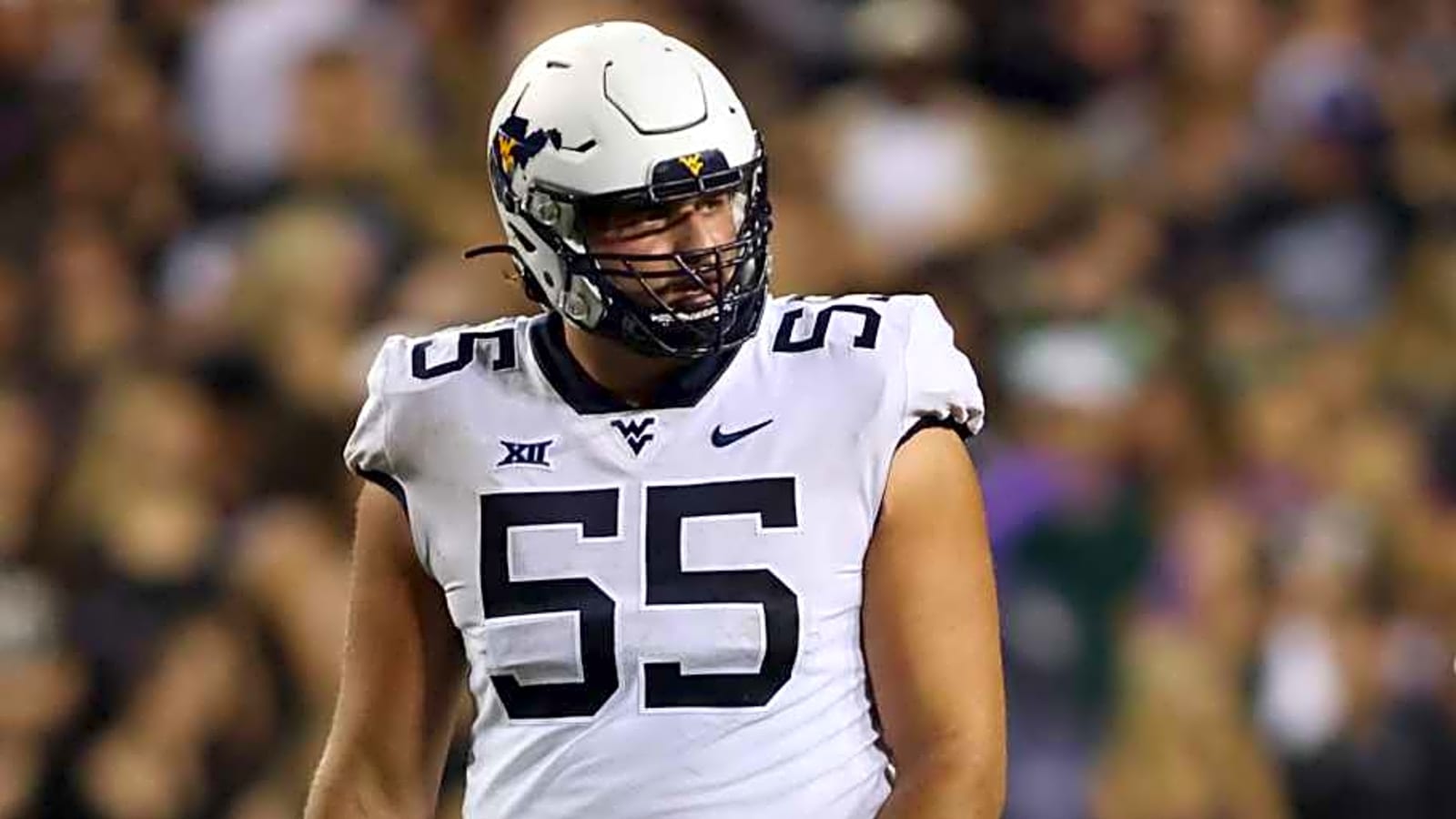
Oftentimes, the offensive line can be the separator between an unimpressive quarterback, a serviceable one and a great one. They're the lens through which fans view their teams' quarterback, based on their protection in the pocket. The same goes for their run blocking and whether they can adequately create enough space for the backs to gain yardage.
And that was a problem for Virginia Tech last year, especially towards the latter half of the season. In two starts and an abbreviated game against Duke, the Hokies' second-stringer William "Pop" Watson absorbed 15 sacks. Part of that boiled down to Watson's lack of true game time experience, but the offensive line wasn't much help.
In the season and a half before Drones went down against Clemson, he took 35 sacks in 20 starts. That's a slightly misleading stat: Drones operates both inside and outside the pocket, functioning as a serviceable passer who can dash to the outside if needed. Back in October, former Virginia Tech on SI writer RJ Schafer said the following about Drones at the season's midpoint:
"He scrambles out of the pocket well, and he can run like a running back when he tucks the ball."
That means Drones’ sack numbers are partly due to situations where defenses flush him from the pocket and he can’t escape. Still, the offensive line needs to take a step forward this season to give Drones better protection. Here's a look at how Tech's revamped its offensive line, both in its characters and in its philosophy. Let's start with who's the new offensive line coach.
Offensive Line Coach - Matt Moore
Former O-line coach Ron Crook is gone from Blacksburg, having exited alongside defensive coordinator Chris Marve and senior director of strength and conditioning Dwight Galt IV prior to the Hokies' bowl game against Minnesota. In his stead comes Matt Moore, who enters his 29th season of coaching. Moore was a nominee in 2023 for the Broyles Award, which designates the top assistant coach in college football.
Prior to coming to Tech, Moore was the offensive line coach at West Virginia (2019-2024), Troy (2006, 2015-17), Louisiana Tech (2013-14), Middle Tennessee (2012), Texas Tech (2007-11). He's been around the college game for a long time and his methodology is rather simple.
"You want to move people and knock people back, but what you don't want to do is knock somebody back one time and then turn a guy loose two times," he said in August of last year to John Antonik, West Virginia's senior director of athletics content. "It's about communicating and understanding defenses and getting hats on hats. The second part is straining every snap and understanding to play offensive line, you've got to strain. That's the two things we work on every single day."
Constant effort and ensuring that offensive linemen consistently engage with a defender is in Moore's credo, as is adaptability. Though Moore’s been in college football for nearly three decades, he's adaptable and maintains a flexible rotation, allowing him to mix starters and backups so each lineman gains experience working with different combinations and against varied defensive looks.
"If you were out there today, you would have no idea who our starting five was because every period I had different guys working together," he said to Antonik, while still with the Mountaineers. "It's not just ones and twos, but three of the starters with two of the second-team guys and three of the second-team guys with two starters."
Although he’s no longer in Morganville, that philosophy should extend to Blacksburg, where Pry has spoken highly of him and trusts his ability to lead the offensive line.
"I am thrilled to add Matt Moore to our staff," Pry said in Virginia Tech's press release. "He brings extensive experience coaching offensive lines at the Power Four level. His proven ability to develop strong, tough offensive line units that play with exceptional physicality will be a tremendous asset to our program. His leadership and expertise align perfectly with our vision for Virginia Tech football.”
Now, let's look at who Moore will have at his disposal for his inaugural campaign in Blacksburg.
Left Guard/Right Tackle - Tomas Rimac/Layth Ghannam
Rimac likely slots in as the No. 1 option for Tech's offensive line and should play in a vast majority of the Hokies' snaps this season, barring injury. He's not a long-term option, possessing only one year of remaining eligibility, but what he lacks in time remaining is made up for in spades by power and ferocity.
Here's what 247 Sports recruiting analyst Allen Trieu said on him coming out of high school in 2020:
"Two-way player who was recruited by some schools on defense. Coordinated player with good strength and is an excellent thrower in track and field. Plays with intensity and when combined with that strength, allows him to maul in the run game. Needs more experience in pass pro against elite edge rushers. Good, solid all-around athlete but can still get more explosive and quick. Upside is high though based on recent growth and multi-sport background. Projects safely as a Power Five starter with higher upside as a potential draft choice."
In 2023, Rimac did not surrender a sack, accumulated 21 knockdowns and possessed the second most "great blocks" on the team with 63. He's a plug-and-play starter who can slot in at right tackle if needed, allotting Tech more versatility. Layth Ghannam can do the same; OurLads has him slotted in at right tackle, though he started last season at left guard. Ghannam played in seven games, making three starts last season in a campaign abbreviated due to injury. I could see Rimac at left guard; he played there for the Mountaineers, but suited up at right tackle during the spring game. How Pry and Moore orient their line for Week 1 is something to keep a tab on.
Center - Kyle Altuner
Altuner brings impressive versatility and upside to Virginia Tech’s offensive line. Although he redshirted at West Virginia last season due to a lower‑body injury, he has four years of eligibility remaining and is viewed as a long‑term contributor.
At Our Lady of Good Counsel HS, Altuner was a dominant force: a three‑time MaxPreps All‑American and Under Armour All‑American who didn’t allow a sack as a senior and gave up just three pressures that campaign.
His familiarity with Moore’s system should help him ramp up quickly for significant snaps in 2025.
Left Tackle - Johnny Garrett
Garrett is an interesting option; he played tight end in high school before converting into a right tackle coming into college. Garrett's shown the chops to play at left tackle, though, having taken the position briefly when Xavier Chaplin went down against Old Dominion then again during the bowl game.
Right Guard - Brody Meadows
Meadows played at left guard in the bowl game, though that spot is rather crowded due to Rimac and Ghannam already occupying that space. I could see Meadows shifting to the other guard slot and competing with Montavious Cunningham for the starting job there.
Backup Options
Like Rimac, Jaden Muskrat serves as a plug-and-play option, one who could provide adequate play at right tackle, left tackle or left guard. Given that Rimac could occupy either the first or third slots, Muskrat's easiest path to playing time, barring another player's injury, could be at left tackle. Lucas Austin, is another player who could earn time at left tackle or right tackle if called upon. However, I think that he remains on the second team unless an injury comes up.
Here's what 247 Sports' Trieu said on Austin coming out of high school:
"Shows tenacity and will play to the whistle and finish. For a taller guy, shows he can bend and get pad level. Still has to get stronger and continue to work on his pass set, but the raw tools and demeanor are there for him to be a Power Five starter in time and have an opportunity to play beyond college."
Regardless of whether Austin, Muskrat or others make their way into the starters, the Hokies will count on a deeper rotation than last year to keep the offensive line fresh and build continuity up front.
More must-reads:
- Kirby Smart shares thoughts on potential Nick Saban coaching return
- Five ACC games that will shape College Football Playoff
- The 'Most recent cycle by MLB franchise' quiz
Breaking News
Trending News
Customize Your Newsletter
 +
+
Get the latest news and rumors, customized to your favorite sports and teams. Emailed daily. Always free!








